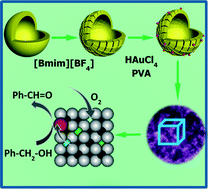A mild and environmentally benign strategy towards hierarchical CeO2/Au nanoparticle assemblies with crystal facet-enhanced catalytic effects for benzyl alcohol aerobic oxidation†
Abstract
The exposure of the crystallographic facets of CeO2 nanocrystals may alter their surface structure and composition, leading to significant discrepancies in their reactivity with respect to catalyzing different reactions. In this paper, a facile strategy of etching hollow CeO2 spheres (@CeO2) with a fluorine-containing ionic liquid (IL), 1-butyl-3-methylimidazolium tetrafluoroborate ([Bmim][BF4]), under hydrothermal conditions was developed to achieve surface-fluorinated @CeO2 nanoparticles with exposed active high-energy facets, which were further assembled in situ into @CeO2 nanoparticle assemblies. The IL, [Bmim][BF4], is believed to play an important role in determining the formation of CeO2 nanoparticles, and the mild release of fluorine species from [Bmim][BF4] may account for the surface-fluorination and the exposure of active high-energy facets of CeO2. The CeO2 nanoparticle assemblies are ideal model materials for studying crystal facet-dependent catalytic behavior. By loading well-dispersed Au nanoparticles via a sol-impregnation method, @CeO2/Au nanoparticle assemblies were achieved, which showed an enhanced catalytic performance for benzyl alcohol aerobic oxidation. In comparison with @CeO2/Au nanoparticle assemblies obtained by etching @CeO2 spheres with other fluorine-containing agents, NH4BF4, NaBF4, and NH4F, under identical reaction conditions, @CeO2/Au nanoparticle assemblies achieved by etching with [Bmim][BF4] exhibited the highest catalytic activity for benzyl alcohol aerobic oxidation. The surface-fluorination and the exposure of active high-energy facets of CeO2 nanoparticles are believed to be responsible for the enhancement of their catalytic activity. This methodology provides a robust strategy to create CeO2 materials with the active high-energy facets exposed and afford model materials for investigating crystal facet-dependent catalytic behavior, which currently represents an exciting issue in the nanocatalysis community.


 Please wait while we load your content...
Please wait while we load your content...